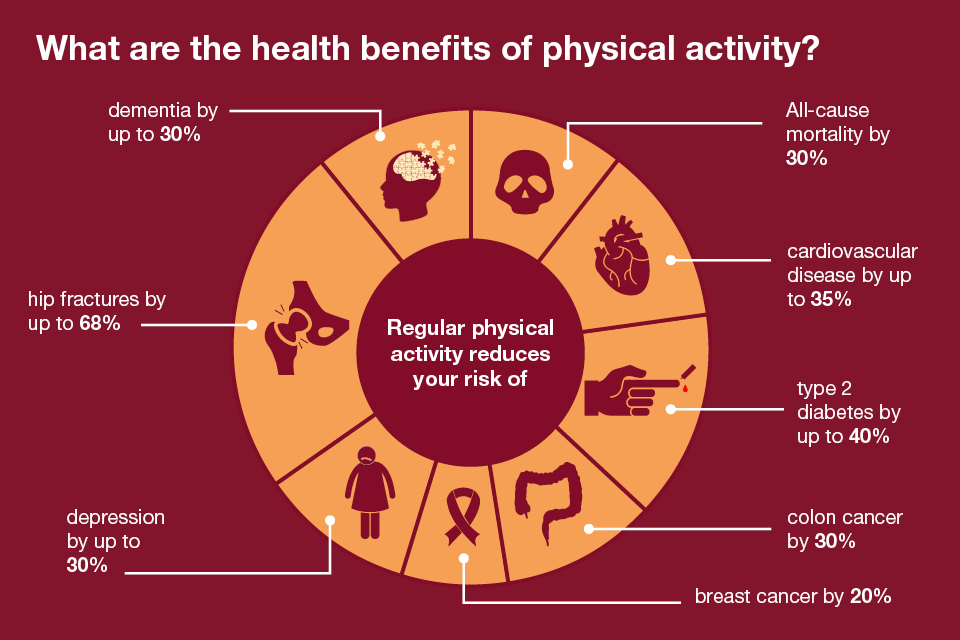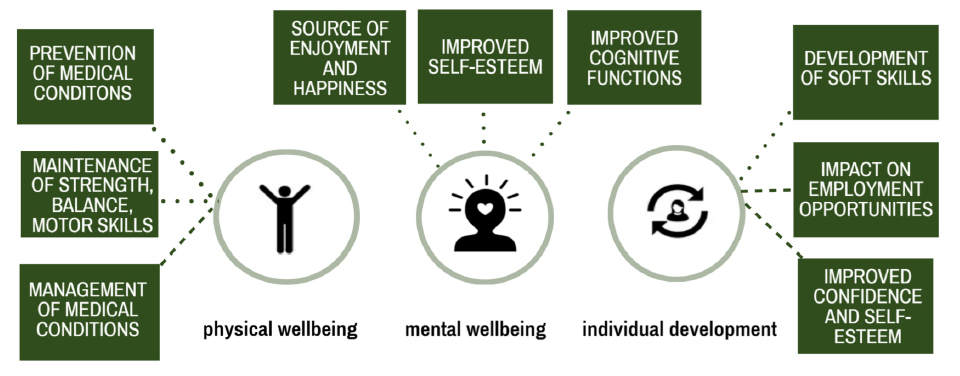Get Cheshire West Moving
Introduction
Being physically active is an essential part of living a healthy and fulfilling life. Across the life course, regular physical activity provides significant physical, mental, and social benefits. Despite these benefits, many people are not active enough. The Get Cheshire West Moving Strategy aims to make it easier for residents to be active, more often, in ways they enjoy.
The Get Cheshire West Moving Strategy supports the Cheshire West Place Plan and the Cheshire West and Chester Borough Plan.
Physical activity is also an important component of other strategies and policies at a borough level. Strategies and plans of note include:
- Sports Facility Strategy
- Cheshire West and Chester Open Space Study
- Cheshire West and Chester Playing Pitch Strategy 2024
- Local Cycling and Walking Infrastructure Plan (LCWIP) (2020 - 2030)
- Public Rights of Way Improvement Plan (ROWIP)
- Climate Emergency Response Plan
- Local Transport Plan
Why is it important to be active?
Physical activity is crucial for children and young people. It promotes healthy growth and development, improves cardiovascular health, strengthens bones and muscles, helps maintain a healthy weight, and boosts overall mental wellbeing. Regular physical activity also enhances cognitive function, concentration, and academic performance. It teaches important life skills like teamwork, communication, and discipline while reducing the risk of chronic disease in later life.
When it comes to adulthood, the benefits of physical activity are wide-ranging (see Figure 1). People who have a physically active lifestyle have a 20-35% lower risk of developing cardiovascular disease compared to those who are inactive. Regular physical activity is also associated with a reduced risk of diabetes, obesity, some cancers, and more years spent in good health. Furthermore, being active supports good mental health, and helps to foster social connections. In older adults, physical activity is associated with increased functional capacities. A wide range of physical activity benefits are displayed in Figure 2.


Figure 1: Health benefits of physical activity for adults. (i) Public Health England (now disbanded).


Figure 2: Wider role and benefits of physical activity. Public Health England (now disbanded)
Despite the widely reported benefits of physical activity, most adults across the UK are insufficiently active to meet the full set of recommendations set out in the UK Chief Medical Officers’ Guidelines on Physical Activity.
How can we be active?
Being physically active will look different to different people. How people choose to be active will depend on many factors including age, sex, where they live, where they work, how their friends are active, cost, time, caring responsibilities, among other factors. It is important to validate all types of movement and physical activity, supporting people to be active in ways which they enjoy and can fit into their lives. Figure 3 places physical activity into four main categories – active living, active travel, active recreation and active sport.


Figure 3: Health Matters, Public Health England (now disbanded)
How active should we be?
New physical activity guidelines were introduced by the UK Chief Medical Officer in 2019 setting out the volume, duration, frequency and type of activity required across the life course to achieve general health benefits. These update the existing guidelines for adults, children and young people, early years (under 5's - infants who are not yet walking and children capable of walking), older people (65+ years), disabled adults, and pregnant women.
The guidelines allow for more flexibility in achieving recommended levels of physical activity and recognise the potential benefits of "small behavioural changes and tailored messages to address inequalities”.
The guidelines state that:
- Infants should be physically active several times every day in a variety of ways, including interactive floor-based activity, e.g. crawling.
- For infants not yet mobile, this includes at least 30 minutes of tummy time spread throughout the day while awake (and other movements such as reaching and grasping, pushing and pulling themselves independently, or rolling over); more is better.
- 1-to 4-year-olds should achieve at least 180 minutes of movement per day, this can include a range of physical activity such as jumping, using playground equipment, climbing, skipping, messy play, walking, swimming, cycling, scooting and playing with objects.
- For 3-4 year olds the 180 minutes should include 60 minutes of moderate to vigorous physical activity.
- Guidelines state that 5- to 18-year-olds should engage in medium (brisk walking or cycling) to vigorous physical activity (running) for an average of at least 60 minutes per day across the week. This can include all forms of activity such as physical education, active travel, after-school activities, play and sports.
- Children and young people should engage in a variety of types and intensities of physical activity across the week to develop movement skills, muscular fitness and bone strength.
- Children and young people should aim to minimise the amount of time spent sedentary, and where physically possible should break up long periods of not moving with at least light physical activity.
In February 2022, new Guidelines on Physical Activity for Disabled Children and Young People were published. The recommendation includes:
- Undertake 120 minutes (2 hours) to 180 minutes (3 hours) of aerobic physical activity per week at a moderate to vigorous intensity.
- Complete challenging, but manageable, strength and balance activities three times per week, which are particularly beneficial for muscle strength and motor skills.
- To support good physical and mental health, adults should aim to be physically active every day. Any activity is better than none, and more is better still.
- Adults should do activities to develop or maintain strength in the major muscle groups. These could include heavy gardening, carrying heavy shopping, or resistance exercise. Muscle strengthening activities should be done on at least two days a week, but any strengthening activity is better than none.
- Each week, adults should accumulate at least 150 minutes (2.5 hours) of moderate intensity activity (such as brisk walking or cycling); or 75 minutes of vigorous intensity activity (such as running); or even shorter durations of very vigorous intensity activity (such as sprinting or stair climbing); or a combination of moderate, vigorous and very vigorous intensity activity.
- Adults should aim to minimise the amount of time spent being sedentary, and when physically possible should break up long periods of inactivity with at least light physical activity.
- Older adults should participate in daily physical activity to gain health benefits, including maintenance of good physical and mental health, wellbeing, and social functioning. Some physical activity is better than none. Even light activity brings some health benefits compared to being sedentary, while more daily physical activity provides greater health and social benefits.
- Older adults should maintain or improve their physical function by undertaking activities aimed at improving or maintaining muscle strength, balance and flexibility on at least two days a week. These could be combined with sessions involving moderate aerobic activity or could be additional sessions aimed specifically at these components of fitness.
- Each week older adults should aim to accumulate 150 minutes (2.5 hours) of moderate intensity aerobic activity, building up gradually from current levels. Those who are already regularly active can achieve these benefits through 75 minutes of vigorous intensity activity, or a combination of moderate and vigorous activity, to achieve greater benefits. Weight-bearing activities which create an impact through the body help to maintain bone health.
- Older adults should break up prolonged periods of being sedentary with light activity when physically possible, or at least with standing, as this has distinct health benefits for older people.
Physical activity guidelines - infographics
Physical activity for early years: birth to 5 years
PDF
377 KB
Physical activity for early years: birth to 5 years (text of the infographic)
HTML
68 KB
Physical activity for children and young people: 5 to 18 years
PDF
362 KB
Physical activity for children and young people: 5 to 18 years (text of the infographic)
HTML
68 KB
Physical activity for disabled children and disabled young people
PDF
393 KB
Physical activity for disabled children and disabled young people: text of the infographic
HTML
70 KB
Physical activity for adults and older adults: 19 and over
PDF
550 KB
Physical activity for adults and older adults: 19 and over (text of the infographic)
HTML
72 KB
Physical activity for disabled adults
PDF
365 KB
Physical activity for disabled adults: text of the infographic
HTML
65 KB
Physical activity for pregnant women
PDF
379 KB
Physical activity for pregnant women (text of the infographic)
HTML
65 KB
Physical activity for women after childbirth: birth to 12 months
PDF
72 KB
Physical activity for women after childbirth: birth to 12 months (text of the infographic)
HTML
66 KB

